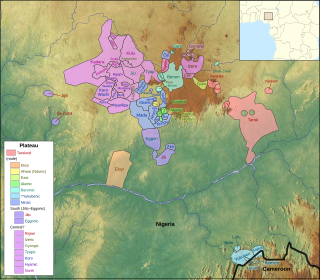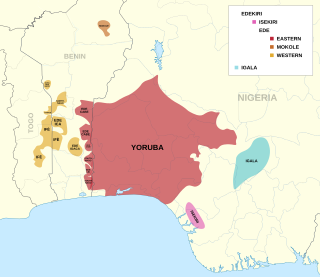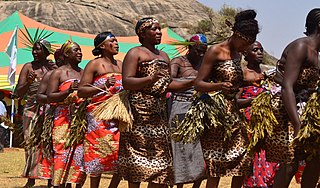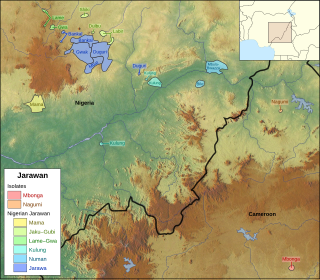Related Research Articles
Tiv is a Tivoid language spoken in some states in North Central Nigeria, with some speakers in Cameroon. It had over 5 million speakers in 2020. The largest population of Tiv speakers are found in Benue state in Nigeria. The language is also widely spoken in the Nigerian states of Plateau, Taraba, Nasarawa and Cross River as well as the FCT Abuja. It is by far the largest of the Tivoid languages, a group of languages belonging to the Southern Bantoid languages

The forty or so Plateau languages are a tentative group of Benue–Congo languages spoken by 15 million people on the Jos Plateau Southern Kaduna, Nasarawa State and in adjacent areas in central Nigeria.

Yoruboid is a 'megagroup' of 14 related language clades, composed of the Igala group of dialects spoken in south central Nigeria, and the Edekiri group spoken in a band across Togo, Ghana, Benin and southern Nigeria, including the Itsekiri of Warri Kingdom.
Eggon, erroneously referred to as Mada - formerly a Plateau language spoken in central Nigeria. It is one of the major language in Nasarawa State.
Cakfem-Mushere is an Afro-Asiatic language cluster spoken in Bokkos LGA, Plateau State, Nigeria. Dialects are Kadim-Kaban and Jajura. Mutual intelligibility with Mwaghavul is high.

The South Bauchi languages are a branch of West Chadic languages that are spoken in Bauchi State and Plateau State, Nigeria.

Ron is an Afro-Asiatic language cluster spoken in Plateau State, Nigeria. Dialects include Bokkos, Daffo-Mbar-Butura, Monguna. Blench (2006) considers these to be separate languages.
The Kyoli or Cori (Chori) language is a Plateau language spoken in Southern Kaduna State, Nigeria.
The twenty Central Plateau languages are a residual branch of the Plateau family spoken in central Nigeria. Tyap has 130,000 speakers, and the closely related Jju has well over 300,000. Hyam has another 100,000. Cori is famous for being one of very few languages with six tone levels, though only three are needed for writing.
Lunguda (Nʋngʋra) is a Niger–Congo language of Nigeria. They settle western part of Gongola mainly in and around the hills of the volcanic Lunguda Plateau, Adamawa state. Joseph Greenberg counted it as a distinct branch, G10, of the Adamawa family. When Blench (2008) broke up Adamawa, Lunguda was made a branch of the Bambukic languages.
Ukaan is a poorly described Niger–Congo language or dialect cluster of uncertain affiliation. Roger Blench suspects, based on wordlists, that it might be closest to the (East) Benue–Congo languages. Blench (2012) states that "noun-classes and concord make it look Benue-Congo, but evidence is weak."

Jarawan is a group of languages spoken mostly in Bauchi State, Nigeria, with some also scattered in Plateau State, Taraba State, and Adamawa State in the same country. Two related languages formerly spoken in Cameroon are now extinct but are believed to have belonged to the group. This connection between Nigerian and Cameroonian Jarawan is attributed to Thomas (1925). Whether Jarawan languages are best classified alongside other Bantu languages or among non-Bantu Bantoid languages is a matter of ongoing debate. A number of descriptions and classifications in the early 20th century suggest that they be may historically related to Bantu languages but not necessarily Bantu themselves. Other perspectives based on lexicostatistic modeling and other phylogenetic techniques for language comparison argue instead that Jarawan languages are properly classified alongside Zone A Bantu languages (A31-A40-A60). For classifications based on these more recent studies, see for example Blench (2006), Piron (1997), and Grollemund (2012).
The East Kainji languages are spoken in a compact area of the Jos Plateau in Nigeria, near Jos. There are more than 20 of them, most of which are poorly studied.
Berom or Birom is the most widely spoken Plateau language in Nigeria. The language is locally numerically important and is consistently spoken by Berom of all ages in rural areas. However, the Berom are shifting to Hausa in cities. The small Cen and Nincut dialects may be separate languages. Approximately 1 million (2010) people speak in this language.
Kwanka, or Kwang (Kwaŋ), is a dialect cluster of Plateau languages in Nigeria.
Tyap is a regionally important dialect cluster of Plateau languages in Nigeria's Middle Belt, named after its prestige dialect. It is also known by its Hausa exonym as Katab or Kataf. It is also known by the names of its dialectical varieties including Sholyio (Morwa), Fantswam (Kafanchan), Gworok (Kagoro), Takad (Attakar), "Mabatado", Tyeca̱rak (Kacecere) and Tyuku (Tuku). According to Blench (2008), Jju—with more speakers—appears to be a form of Tyap.
Polci is an Afro-Asiatic language of Bauchi State, Nigeria. It is part of the Barawa cluster, which is in turn part of the West Chadic language family.

The Ron, Ronic or Ron–Fyer languages, group A.4 of the West Chadic branch of the Afro-Asiatic language family, are spoken in Plateau State, north-central Nigeria.
The Ham people are an ethnic group found in the southern part of Kaduna State in the northwestern region of Nigeria, predominantly in Jaba, Kachia and Kagarko Local Government Areas of southern Kaduna State, Nigeria. They speak the Hyam language and refer to themselves as Ham. They are known as the 'Jaba' in Hausa, but a recent study by a linguist who is a native of the area has definitely proven that the label 'Jaba' was derogatory and should be rejected. Some estimates place the Ham as numbering 400,000.
Southern Kaduna is an area inhabited by various non-Hausa peoples living south of Zaria Emirate of Kaduna State. It is located in the Middle Belt region of Nigeria. Southern Kaduna consist of 12 local Government out of Kaduna State 23 Local Government. Some view it as being less of a geographical identity and more of an ethnic identity concept.
References
- ↑ Hyam at Ethnologue (18th ed., 2015) (subscription required)
- ↑ Blench, Roger (2019). An Atlas of Nigerian Languages (4th ed.). Cambridge: Kay Williamson Educational Foundation.
- ↑ "Hyam Wordlist"